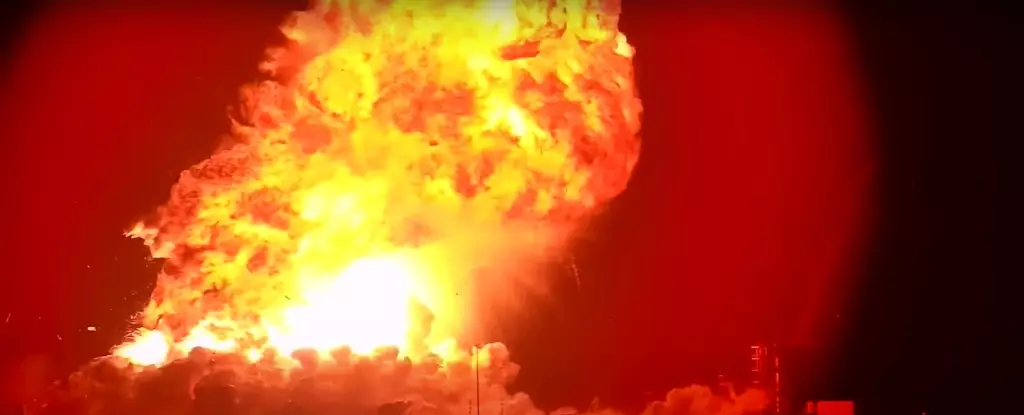In an unfortunate yet revealing incident, SpaceX’s Starship rocket experienced a catastrophic explosion during a routine ground test on a Wednesday evening at the company’s extensive Starbase facility in Texas. This event is a stark reminder of the unpredictable nature of cutting-edge aerospace engineering, especially as SpaceX ambitiously aims to launch humans to Mars. The explosion occurred around 11 PM local time, sending a massive fireball into the night sky, raising questions about both safety protocols and the technical intricacies involved in building the world’s most powerful rocket.
Despite the visual spectacle, the incident resulted in no reported injuries, thanks in part to the established safety zones around the test area designed to safeguard personnel. SpaceX’s preliminary investigations suggested a potential failure linked to a composite overwrapped pressure vessel (COPV) containing gaseous nitrogen, which may have contributed to the explosion. While such setbacks are disheartening, they are remarkably common in the realm of space exploration, where trial and error play a significant role in progress.
Understanding the Static Fire Test
The Starship’s static fire test—an essential phase before any planned launch—serves a critical purpose: it allows engineers to test the rocket’s engines and performance while anchored to the ground. Key to this procedure is the Super Heavy booster, which is designed to contain the rocket when its engines are fired. The successful execution of such tests is vital in gathering data and rectifying any potential issues before embarking on live missions. However, the latest incident at Starbase is a clear indication that even the best-laid plans can encounter unforeseen challenges.
Elon Musk, the visionary behind SpaceX, projected a resilient attitude regarding the explosion, claiming on social media that the incident was merely “a scratch.” This statement encapsulates the culture of risk-taking that Musk promotes within his company—a culture where failures are not seen as dead ends but rather as steps in a continual learning process. This mindset is emblematic of how SpaceX has adapted and thrived in an industry riddled with obstacles and setbacks.
The Impact on Musk’s Mars Colonization Dream
Musk’s grand aspiration of establishing a sustainable human presence on Mars hinges significantly on the success of Starship. Standing at a staggering height of 403 feet, this behemoth is billed as fully reusable, capable of carrying payloads up to 150 metric tons—a critical factor in enabling deep-space missions. While the explosive incident raises legitimate concerns regarding the rocket’s engineering reliability, it is unlikely to deter Musk’s relentless pursuit of space exploration. Rather, such challenges often ignite a renewed drive for innovation and improvement.
Furthermore, SpaceX’s experimental approach to engineering—encapsulated in the ethos of “fail fast, learn fast”—has successfully positioned the company as a leader in commercial spaceflight. Despite the setbacks, the company has reported notable successes, including the recovery of Super Heavy boosters using its monumental robotic arms. This capability not only underscores their engineering prowess but also highlights their commitment to enhancing cost-efficiency and sustainability in space travels.
NASA and SpaceX: A Modern Alliance with Significant Implications
The relationship between NASA and SpaceX has taken on increased importance as the latter emerges as a key player in space exploration. With the Dragon spacecraft regularly transporting astronauts to and from the International Space Station, NASA’s reliance on SpaceX continues to grow. Despite this dependency, concerns remain about the environmental implications of SpaceX’s ambitious launch schedule, particularly after the FAA increased Starship’s allowed annual launches from five to twenty-five earlier this year.
Conservation groups have voiced concerns that the heightened activity could pose threats to local wildlife, particularly marine species like sea turtles. This ongoing tension encapsulates the broader conflict between innovation and ecological responsibility—a dilemma that society must navigate as we advance into an era of unprecedented exploration.
The Road Ahead: Learning from Setbacks
Right now, SpaceX is evaluating its systems while meticulously analyzing the failure’s broader implications. While the COPVs in Starship and the Falcon rockets have been deemed distinct, continued investigations are essential for ensuring the safety and reliability of future launches. In a race to conquer the cosmos, each explosion serves as both a lesson and a stepping stone toward the next great breakthrough.
In the high-stakes world of space exploration, resilience is not just desired; it is necessary. SpaceX’s journey is indicative of the dual nature of technological progress, where each triumph is often shadowed by setbacks, yet where the indomitable human spirit continually seeks the stars.

